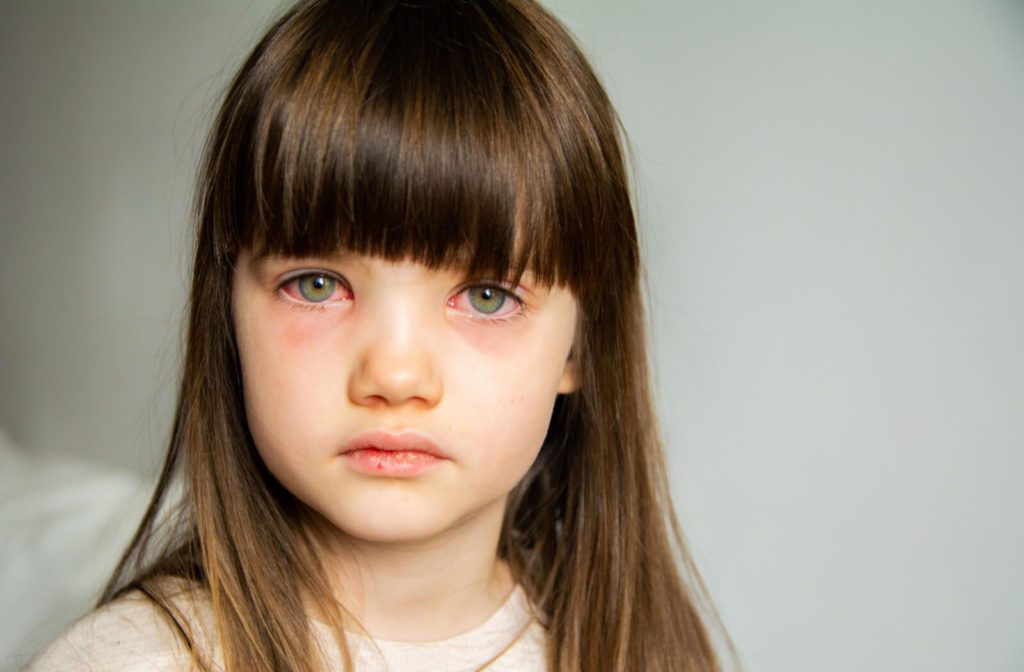Pink eye is a common eye condition that results from an infection of the conjunctiva (membrane lining the eyelid), which becomes inflamed and red or pink.
Pink eye is rarely serious and usually resolves within 1–2 weeks. However, if symptoms last longer and are accompanied by pain, difficulty seeing, or developing light sensitivity, it could be an eye emergency.
Contact your optometrist for prompt evaluation and treatment, or go to your nearest emergency or urgent care center. We discuss types of pink eye, its symptoms, treatment, and when to seek medical attention.
What Is Pink Eye?
Pink eye (conjunctivitis) is inflammation of the conjunctiva. The conjunctiva is the clear membrane that lines the inner eyelids and covers the whites of your eyeball.
Pink eye can affect one or both eyes and appears pink or red when the tiny blood vessels in the whites of your eye become inflamed. Some types of pink eye can spread rapidly, especially in children, but usually doesn’t affect your vision.
Causes of Pink Eye
The most common causes of pink eye are bacteria, viruses, and allergens. Other causes include:
- Chemicals
- Contact lens wear
- Foreign material in the eye, such as an eyelash
- Smoke, dust, fumes, or chemical vapors
- Fungi
- Amoeba and parasites
- Blocked duct (in newborns)
Types of Pink Eye
The different types of pink eye are based on the factors that cause them. These include:
Bacterial Conjunctivitis
In bacterial conjunctivitis, the infection is caused by certain bacteria. This type is very contagious and more common in children than adults.
Symptoms of bacterial conjunctivitis are:
- Sore eyes
- Red or pink eyes
- Sticky pus in the eye (sometimes little or no discharge)
Viral Conjunctivitis
Viral conjunctivitis is the most common type and is caused by different viruses, usually the same virus that causes a runny nose and sore throat. It’s also very contagious and can cause large outbreaks.
Symptoms of viral conjunctivitis are:
- Burning eyes
- Red eyes
- Watery discharge
Allergic Conjunctivitis
Allergic conjunctivitis results from an allergic reaction to allergens such as pollen, dust mites, mold, pets, smoke, or fumes. It can occur seasonally with outdoor allergens or anytime with indoor allergens.
Allergic conjunctivitis can occur more in people with other allergies like hay fever or asthma, usually occurs in both eyes, and isn’t contagious.
Symptoms of allergic conjunctivitis include:
- Itchy eyes
- Burning eyes
- Red eyes
- Watery eyes
- Puffy eyelids
Treatment for Pink Eye
Treatment isn’t always necessary since pink eye usually goes away within 2 weeks. However, if symptoms last longer, treatment depends on the type of pink eye.
Treatment for bacterial conjunctivitis is antibiotics, and sometimes also eye drops or an ointment to apply to the inside of the eyelid. With antibiotics, symptoms typically improve within a few days. Even if symptoms disappear, always take the prescribed medication as directed by your eye doctor.
Because viral conjunctivitis is caused by the same virus as your common cold, there isn’t any treatment, and mild symptoms generally resolve in less than 10 days. To soothe symptoms, you can use a warm compress.
If it’s caused by herpes simplex or varicella-zoster virus, you may be prescribed antiviral treatment. Since viral conjunctivitis is contagious, you can take steps to prevent its spread:
- Wash your hands frequently
- Avoid touching your eyes
- Don’t share personal items
- Only use clean towels or tissues to wipe your eyes
- Don’t share cosmetics, such as mascara and eyeliner
- Disinfect surfaces
- Wash pillowcases frequently
Antihistamines are used to treat allergic conjunctivitis. Oral antihistamines or eye drops help to reduce inflammation and provide relief.
For irritants, such as chemical irritants, use lots of water to wash away the substance. If symptoms don’t improve, call your eye doctor immediately. If your condition is severe, your eye doctor may prescribe topical steroids.
For contact lens wearers, it’s best to remove them until the pink eye clears.
When to Seek Urgent Care for Pink Eye
Mild pink eye may resolve by itself, but severe cases may require urgent care as soon as possible. If you have conjunctivitis with the following symptoms and these get worse or don’t improve, seek urgent care:
- Moderate to severe pain in the eye(s)
- Intense redness
- More sensitivity to light
- Blurry vision that doesn’t go away after wiping discharge
- Increased mucus and crustiness after waking
- If you have a weakened immune system
- Newborns with conjunctivitis need immediate medical attention
Emergency Eye Care When You Need It
Pink eye is usually more of an eye sore rather than a vision-threatening condition. But this is not always the case.
If your symptoms worsen, you develop new symptoms that affect your vision, or you’re unsure whether it’s an emergency, call Dr. Henslick Vision Center. Our optometrists can diagnose the type of pink eye you have and provide treatment based on the severity.




